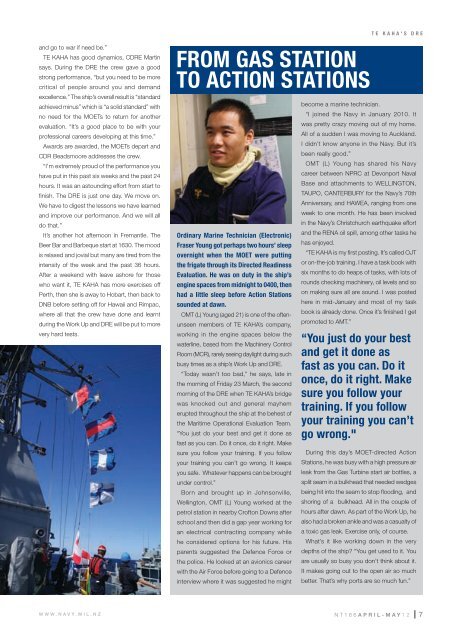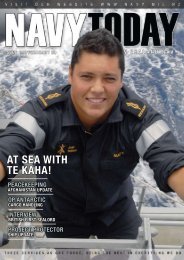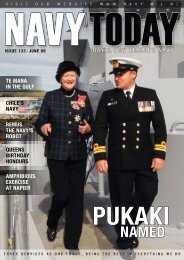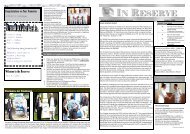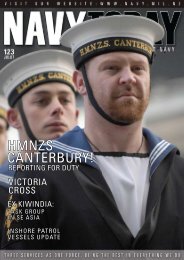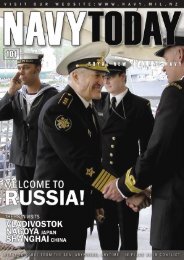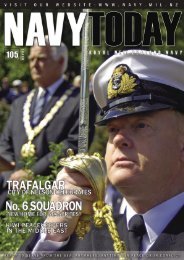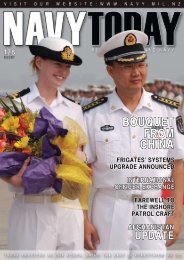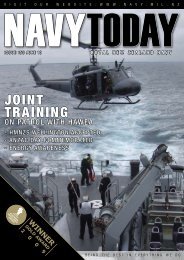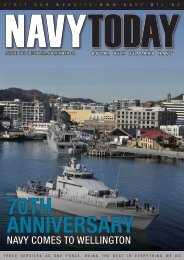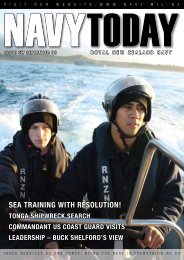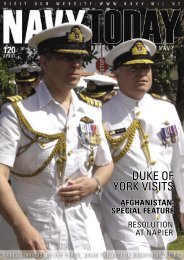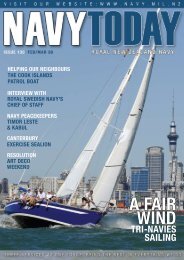May 2012, Issue 166 - Royal New Zealand Navy
May 2012, Issue 166 - Royal New Zealand Navy
May 2012, Issue 166 - Royal New Zealand Navy
Create successful ePaper yourself
Turn your PDF publications into a flip-book with our unique Google optimized e-Paper software.
te kaha's dre<br />
and go to war if need be.”<br />
TE KAHA has good dynamics, CDRE Martin<br />
says. During the DRE the crew gave a good<br />
strong performance, “but you need to be more<br />
critical of people around you and demand<br />
excellence.” The ship’s overall result is “standard<br />
achieved minus” which is “a solid standard” with<br />
no need for the MOETs to return for another<br />
evaluation. “It’s a good place to be with your<br />
professional careers developing at this time.”<br />
Awards are awarded, the MOETs depart and<br />
CDR Beadsmoore addresses the crew.<br />
“I’m extremely proud of the performance you<br />
have put in this past six weeks and the past 24<br />
hours. It was an astounding effort from start to<br />
finish. The DRE is just one day. We move on.<br />
We have to digest the lessons we have learned<br />
and improve our performance. And we will all<br />
do that.”<br />
It’s another hot afternoon in Fremantle. The<br />
Beer Bar and Barbeque start at 1630. The mood<br />
is relaxed and jovial but many are tired from the<br />
intensity of the week and the past 36 hours.<br />
After a weekend with leave ashore for those<br />
who want it, TE KAHA has more exercises off<br />
Perth, then she is away to Hobart, then back to<br />
DNB before setting off for Hawaii and Rimpac,<br />
where all that the crew have done and learnt<br />
during the Work Up and DRE will be put to more<br />
very hard tests.<br />
FROM GAS STATION<br />
TO ACTION STATIONS<br />
Ordinary Marine Technician (Electronic)<br />
Fraser Young got perhaps two hours’ sleep<br />
overnight when the MOET were putting<br />
the frigate through its Directed Readiness<br />
Evaluation. He was on duty in the ship’s<br />
engine spaces from midnight to 0400, then<br />
had a little sleep before Action Stations<br />
sounded at dawn.<br />
OMT (L) Young (aged 21) is one of the oftenunseen<br />
members of TE KAHA’s company,<br />
working in the engine spaces below the<br />
waterline, based from the Machinery Control<br />
Room (MCR), rarely seeing daylight during such<br />
busy times as a ship’s Work Up and DRE.<br />
“Today wasn’t too bad,” he says, late in<br />
the morning of Friday 23 March, the second<br />
morning of the DRE when TE KAHA’s bridge<br />
was knocked out and general mayhem<br />
erupted throughout the ship at the behest of<br />
the Maritime Operational Evaluation Team.<br />
“You just do your best and get it done as<br />
fast as you can. Do it once, do it right. Make<br />
sure you follow your training. If you follow<br />
your training you can’t go wrong. It keeps<br />
you safe. Whatever happens can be brought<br />
under control.”<br />
Born and brought up in Johnsonville,<br />
Wellington, OMT (L) Young worked at the<br />
petrol station in nearby Crofton Downs after<br />
school and then did a gap year working for<br />
an electrical contracting company while<br />
he considered options for his future. His<br />
parents suggested the Defence Force or<br />
the police. He looked at an avionics career<br />
with the Air Force before going to a Defence<br />
interview where it was suggested he might<br />
become a marine technician.<br />
“I joined the <strong>Navy</strong> in January 2010. It<br />
was pretty crazy moving out of my home.<br />
All of a sudden I was moving to Auckland.<br />
I didn’t know anyone in the <strong>Navy</strong>. But it’s<br />
been really good.”<br />
OMT (L) Young has shared his <strong>Navy</strong><br />
career between NPRC at Devonport Naval<br />
Base and attachments to WELLINGTON,<br />
TAUPO, CANTERBURY for the <strong>Navy</strong>’s 70th<br />
Anniversary, and HAWEA, ranging from one<br />
week to one month. He has been involved<br />
in the <strong>Navy</strong>’s Christchurch earthquake effort<br />
and the RENA oil spill, among other tasks he<br />
has enjoyed.<br />
“TE KAHA is my first posting. It’s called OJT<br />
or on-the-job training. I have a task book with<br />
six months to do heaps of tasks, with lots of<br />
rounds checking machinery, oil levels and so<br />
on making sure all are sound. I was posted<br />
here in mid-January and most of my task<br />
book is already done. Once it’s finished I get<br />
promoted to AMT.”<br />
“You just do your best<br />
and get it done as<br />
fast as you can. Do it<br />
once, do it right. Make<br />
sure you follow your<br />
training. If you follow<br />
your training you can’t<br />
go wrong."<br />
During this day’s MOET-directed Action<br />
Stations, he was busy with a high pressure air<br />
leak from the Gas Turbine start air bottles, a<br />
split seam in a bulkhead that needed wedges<br />
being hit into the seam to stop flooding, and<br />
shoring of a bulkhead. All in the couple of<br />
hours after dawn. As part of the Work Up, he<br />
also had a broken ankle and was a casualty of<br />
a toxic gas leak. Exercise only, of course.<br />
What’s it like working down in the very<br />
depths of the ship? “You get used to it. You<br />
are usually so busy you don’t think about it.<br />
It makes going out to the open air so much<br />
better. That’s why ports are so much fun.”<br />
WWW.NAVY.MIL.NZ NT<strong>166</strong>april-may12 7


